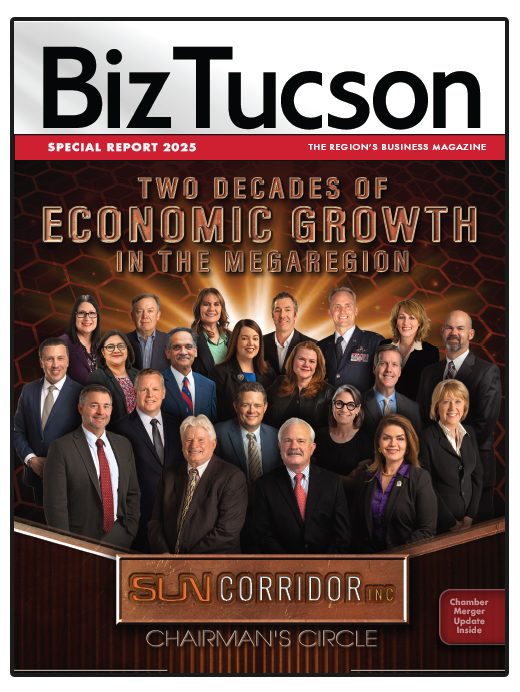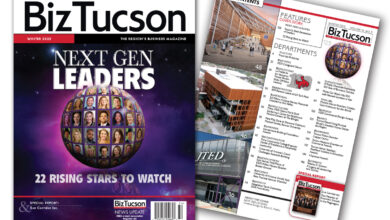
20 Years Strong
Sun Corridor Inc. Boasts $39 Billion Impact, Economic Synergy for Region
By Jay Gonzales
With a series of significant scores under its proverbial belt in its 20 years of existence, Sun Corridor Inc. knows it’s never time to just start running clock and play defense.
The region’s longest running economic development group has worked diligently in partnership with corporate, government and community leaders to transform what was once a difficult business environment, to a successful one that is building a game plan for long-term success.
Caterpillar and Amazon are two industry giants that have planted roots here since 2015. Longtime local employers Raytheon, Bombardier and Roche have had major expansions while also making commitments to keep their presence in the region. Companies invested in future technology such as American Battery Factory, Sion Power and PowerPhotonic decided to headquarter here.
Those notable successes, along with over 200 other company locates and expansions, have added up to an estimated $39 billion impact, primarily through job creation.
As the organization begins its third decade, Sun Corridor Inc. is keeping its offense on the field with a plan to understand how the region is being perceived to continue its competitive edge in the game of economic development. It sounds simple – create jobs and you win – but it’s not.
Joe Snell, president and CEO of Sun Corridor Inc., says there’s way more to it, in particular because the COVID-19 pandemic dramatically changed how business works and consequently completely changed the game.
“Looking back 20 years, good things have happened and there have been some missed opportunities. But with COVID, we’ve seen a major fundamental shift in how business is done,” said Snell, the first and only president of Sun Corridor Inc. since it changed its name from Tucson Regional Economic Opportunities, or TREO, in 2015.
“You’re talking about sea shifts in the way the economy is operating,” he said. “Companies relocate for a couple reasons. One, they’re leaving a bad regulatory environment. But mostly, they’re leaving because it’s easier to attract companies or employees to a high quality-of-life place like Arizona. The game changed because people can live anywhere and work wherever.”
The new environment has brought into focus the fact that employers don’t fund job growth in communities, “they fund economic growth and job growth is a by-product,” Snell said. Understanding that, he said, the question now is how to get competitive and stay competitive for long-term economic growth.
The so-called “sea shift” also got Snell thinking that Sun Corridor Inc., and the region as a whole, had work to do that was different from the previous strategic plans that have helped trigger some of the economic development victories of the last 20 years.
The 2007 Economic Blueprint, its 2014 update, and the 2021 Pivot Playbook have guided Sun Corridor Inc. and economic development in the region to where it is today. But the environment has changed.
“That change got me thinking that we better go figure out how we’re being perceived because what we were counting on 10 years ago is just not valid,” Snell said.
Sun Corridor Inc. spent the last year conducting a comprehensive study: “Competing at a Higher Level: Increasing Southern Arizona’s Economic Competitiveness.”
In its introduction, the study states, “The last several years have caused fundamental shifts in the economy that impact not only what we are competing for but also how we compete. To continue to be competitive and build upon our successes, Southern Arizona must refocus its economic development efforts around the factors that drive economic competitiveness, build on its strengths, and commit to a strategy that prioritizes addressing its biggest challenges.”
“This is just a time of opportunity that we’ve never seen before with all of the onshore tax incentives, and manufacturing, data center and mining growth opportunities,” said Susan Gray, president and CEO of Tucson Electric Power. Gray is in her second year as board chair for Sun Corridor Inc.
“As a region, we’re always in the conversation,” she said. “This is a good opportunity to see some trends, where are we possibly improving, where are we still lagging, and identify some areas that we want to focus on.”
The report, which was authored by Susan Dumon, executive VP at Sun Corridor Inc., focuses on five “key competitive opportunities:”
1. Develop bold, collaborative solutions to regional issues by aligning and strengthening business voices
2. Support new leadership at the University of Arizona to strengthen the institution and continue its legacy of academic excellence
3. Build sustainable economic partnerships between Southern Arizona and Mexico
4. Grow the talent base
5. Accelerate access to Arizona state land to meet market demand
Each of those five points has already seen some action.
In mid-December, Sun Corridor Inc. and the Tucson Metro Chamber announced a merger to address Item 1 in the competitiveness report. They are merging to begin consolidation of the “voices” representing the region’s businesses.
Sun Corridor Inc. has established a formal partnership with Sonora Global, the economic development arm for Sonora, Mexico, to promote trade and economic development as a megaregion.
There’s a new president at the University of Arizona, Suresh Garimella, and Sun Corridor Inc. wants to ensure that he gets the business, government and community support to strengthen the “town and gown” relationship and further focus on developing the talent businesses across the region need. As our region rises, Snell says, so does the UA – and vice versa.
At the outset of developing those five opportunities, Snell said he learned that while there are significant issues the region has to deal with, significant progress has been made in 20 years by Sun Corridor.
“The positivity of the outsiders was different from what I saw 20 years ago,” Snell said. “In that first perception study in 2006, the locals, by far, thought this was a more competitive place than the outsiders did.”
While “locals” felt Tucson was a great place, with a strong university and a strong talent base, Snell said, outsiders weren’t as impressed with UA, the talent was just so-so, and as for living here, it’s hot.
Since then, impressions have changed about what was driving perception of the region. The resurgence of downtown has dramatically improved the quality-of-life factor, Snell said. Site selectors are saying the region is “on the cusp of greatness” but not quite there, which is why Sun Corridor Inc. is looking at competitiveness to develop strategies to get there.
Another burning question: Where is “there?” What does Tucson want to be? And can the five key opportunities in the study get the region “there?”
“I think to a large degree, what it really means is, corporations are going to come and put in nice quality companies here if you can get this figured out. I think what it also means − and it’s a very sensitive subject – is it going to convert you from a sleepy Southwestern town to a town that has business growth, jobs, and income that’s achieving our mission of wealth creation for all. That’s the greatness we can achieve.”






